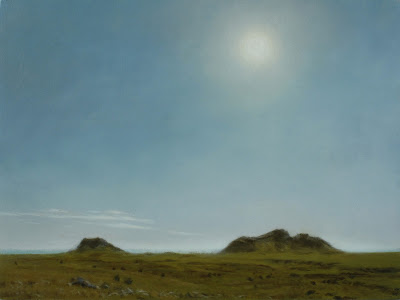oil on canvas 51x51cm
This is based on some photographs of the river Authie that I took in France, in May last year. We had a picnic nearby. There was a field with white cows and I crossed the little bridge to look at them, and this the view along the riverbank.
Compositionally this is fairly orthodox - motion from left to right, and from near to far. The diagonal from the bottom left corner takes the eye back to the far light, and moves you across the painting.
The foliage on the trees caused me a lot of bother, mainly because I wasn’t thinking. I had an idea about making different types of marks as the forms come forward – which does work – but I completely forgot past lessons learnt (the ones about simplifying from near to far). As a result, I allowed the foliage to become far too complicated and it became a bit of a nightmare. I am quite glad that I didn’t overdo the shadows and kept the tones light, as I wanted the light to bounce around a bit.
The two calves were additions, and were sourced from some of the many beautiful Vaches Blanches that we’d seen earlier. The one in shadow is a complete re-work and I’m quite chuffed with how it’s turned out. The figure was invented, and I made three different-sized versions before choosing the one that was just right.
When I was struggling and not knowing how to make the painting work, I played quiet, calm music to settle myself down. This was particularly effective; it’s one of Alexander Scriabin’s Preludes, Op.16 - No.3 in G flat major . It sets the mood of peace and calm that I’m trying to achieve here - which I needed to establish so that I can subvert it. I think I’ve managed that here, but that’s the idea, in case you were wondering.
You may also be wondering about precisely when my solo show is. I mentioned it some months ago, and arrangements are now firm. It will preview on Thursday evening 6th March 2014, and will be on from Friday 7th until (no joke) 1st April. It’ll be at the Union Gallery in Broughton Street, Edinburgh, and has a title – Dark Arcadias.
Not many pictures of fluffy kittens then…














